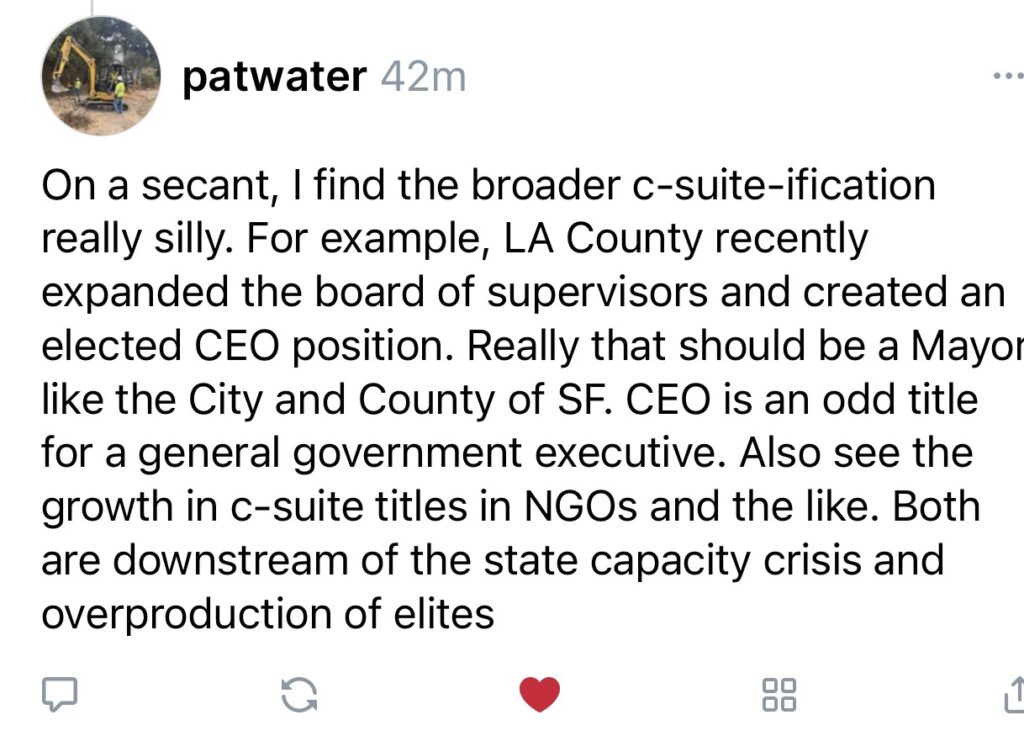The Great Christmas H1-B War of 2024 is the inevitable crash when Tech, high on its own self-congratulatory bullshit, thought it had meat space in lockdown. These are the same people so tangled in their pitch decks they actually believed they could hitch a ride on the venomous wave of Jacksonian nativism—stoking the flames just enough to prop up their handpicked candidates, all while patting themselves on the back for being “progressive” enough to pretend they weren’t courting the very forces that have historically been the death knell for entire cultures.
But nativism isn’t a programmable variable—it’s a primal force, rooted in the same cultural strain that is responsible for the Trail of Tears, the displacement of entire Mexican populations, and the scorched-earth mentality of Manifest. And now, with Musk playing provocateur on X, that force has been roused again—not as a tool for Tech’s ambitions but as an unstoppable tide that doesn’t care about “elite human capital” or strategic hiring practices.
What Tech thought was a clever way to “own the libs” is now spiraling out of control. Aligning with nativist populism to push their agenda was like playing with nitroglycerin: every bump and misstep sets off an explosion. Now, as they try to rally support for their H1-B pipeline, they’re slamming into a brick wall of deep-seated anger and generational trauma—a rage not rooted in economic data or hiring strategies but in the primal need to protect what they see as their homeland.
What’s truly unfolding here is that the Trump administration—an administration that couldn’t give a damn about H1-Bs, Indian immigrants, or any of that tech-centric nonsense—is now in a position to extract real concessions from the industry. They’re not worried about the supply of cheap labor or the flow of skilled immigrants anymore. No, now it’s about infiltrating the platforms, the tech giants, from Google to crypto, with their own people. The deal is on the table, and it’s about power, not principles.
The tech companies, who thought they could dance with nativism without losing their grip on their shiny little empires, are now about to find themselves with former Trump cronies and acolytes crawling into the higher echelons of their organizations. It’s the perfect bait-and-switch: tech, thinking it could leverage nationalism for political gain, is now going to be the one getting leveraged.
Tech’s fatal mistake was thinking their dominance over the digital world made them untouchable in the physical one. They assumed they could stir the pot without spilling it, that their carefully constructed systems of control could withstand the backlash. But now, as their H1-B advocacy smashes into a wall of pure, undiluted rage, it’s clear they never understood the stakes.
The chuds aren’t debating visas or bottom lines. They see Tech as the latest in a long line of invaders, looting their homeland under the guise of progress. And while the tech CEOs scramble to make their case with PowerPoint decks and hashtags, their own “elite human capital” is busy torching what little goodwill remains, gloating about displacement and dominance in a way that only fans the flames.
This isn’t just a PR crisis—it’s a moment of reckoning for an industry that thought it had transcended history. Because meat space, as it turns out, isn’t as secure as they thought. And the forces they’ve awakened don’t bow to algorithms or quarterly reports—they destroy everything in their path, including the hubris that summoned them.
It’s not clear how much they’re going to miss the Democrats yet, but it’s becoming painfully obvious that their flirtation with nativism was a catastrophic miscalculation. They thought they were playing 4D chess, cutting loose the libs for a more pliable power base. Instead, they’ve found themselves neck-deep in a raging cultural inferno, with racists, revanchists and misogynistic while keeping the rules of the game firmly under its control. They assumed that because certain minorities were part of their enterprise—working for them, building their systems, contributing to their bottom lines—they’d somehow be exempt from the wrath of the mobs they’ve emboldened and that the chuds would just go against more traditional minorities like black and Latino.
The logic is psychotically idiotic. As if the same people who’ve been stoking this fire for years, fueled by fear and resentment, would suddenly stop and say, “Oh, not those ones, they’re with the good guys.” As if the monster of nativism can be housebroken with a memo or a motivational TED Talk.
The absurdity lies in believing you can weaponize hate and still dictate its trajectory. That you can stoke the flames without getting burned. But that’s not how this works. Hate is indiscriminate, unthinking, and once unleashed, it doesn’t follow instructions. It devours everything, including the people who thought they could control it.
Meanwhile, this is fantastic news for Trump, Stephen Miller, and the entire Jacksonian nativist right. With the tech industry now scrambling to align itself with their agenda, they’ll be able to start positioning their people right at the top of these organizations—whether it’s in the platforms themselves or the lucrative tech sectors like crypto. What was once a distant battle over H1-Bs and immigration policy is now a full-on power play. They’ll place their loyalists in key positions, leveraging their newfound influence to control the direction of these tech giants, ensuring that the platforms, algorithms, and policies that shape our digital lives reflect their nativist, populist worldview. It’s the perfect storm for them—getting into the very heart of Silicon Valley, while the tech elites, too blinded by their own ambition, fail to see they’ve just handed the keys to their kingdom over to the very people who want to burn it down.
This whole mess feels like the inevitable fallout of tech’s LARPing-as-builders syndrome. The original promise of tech was to disintermediate, streamline, and reimagine systems with minimal scaffolding, using software to make things work faster, leaner, smarter. It wasn’t about reinventing the wheel—it was about putting a turbocharger on it.
But somewhere along the way, that wasn’t enough. Now, a few years in, they’ve decided they need to be builders—grandiose architects of entire ecosystems, spinning up new structures with no understanding of the foundations they’re replacing. The result? A lot of brittle, overengineered nonsense that collapses under its own weight the moment anyone tries to use it in the real world.
It’s like they forgot the first rule of systems: if it works, don’t break it just because you think you can. But tech, drunk on its own mythos, can’t resist. And so, here they are, desperately trying to play “visionary architect” while their creations creak and groan under the strain of reality. It’s not just arrogance—it’s incompetence disguised as innovation.
A lot of the systems they’re trying to replace are racist, revanchist, and misogynist to their core. These aren’t just antiquated architectures—they’re deeply oppressive structures that tech claimed it would disrupt, dismantle, and rebuild better. And instead of grappling with that reality, they pretended for years that the problem wasn’t as bad as it was—or worse, that their shiny new platforms were somehow neutral, magically immune to the rot baked into the foundations they’re built on.
But here’s the thing about ignoring rot: it spreads. And now, it’s coming back to bite them in the butt. All that performative hand-waving about “disruption” and “innovation” was just a distraction from the fact that they never did the hard work of actually addressing the ugliness they were so eager to replace. So instead of progress, we get the same broken systems in a new wrapper—just with more data harvesting and less accountability.
And hopefully—hopefully—this is just a passing spat that burns itself out before it does lasting damage. Maybe cooler heads will prevail, and this wreckage can be steered toward something marginally productive. But let’s be honest, the odds aren’t great when both sides are so committed to tearing each other apart that “winning” has become indistinguishable from mutual destruction.
So how do you say I told you so without actually saying it? You don’t. You sit back, crack a cold one, and watch the tech overlords fumble their way through the mess they made. Because the truth is, anyone with half a brain saw this coming from miles away: you don’t unleash the darker angels of American culture and expect to walk away unscathed. That’s not strategy. That’s hubris. And now, hubris is coming to collect its due.
RECAP
For you who’ve been in a deep Christmas hibernation and just woke up blinking at the mess, let’s do a deep dive
On Government
Jacksonian Right: Government is fine as long as it’s a muscular sheriff with a shotgun, chewing tobacco, and telling brown people to shove off. Anything more complex smells like Ivy League meddling, socialism or child trafficking
Techno-Libertarian Right: Government should be a smartphone app that deletes itself after pump-and-dumping the next Mars colony. If the Department of Defense can be decentralized on the blockchain, great. If not, just slice up the military and sell shares. Anything more involved is tyranny.
Neoconservative Right: Government is an all-knowing, all-seeing guardian angel of freedom and my expense account , tasked with making sure every world country votes correctly, buys U.S. weapons, and watches Top Gun—
On Cultural Values
Jacksonian Right: Culture is barbecues, church potlucks, and Toby Keith lyrics. If it doesn’t involve a flag, a gun, or a front porch, it’s probably un-American. Camo gear is preferred and not having a truck is pretty disqualifying
TechRight: Culture is an 8 bit NFT of a flaming eagle or whatever Roman Empire meme. If the kids are coding it, but they’re not suffering like in the movie whiplash they’re not doing it right. Fun comes years later when you make fun of chuds. Meant to fix cybertruck but didn’t come around to
Neocon Right: It’s the Magna Carta, the Federalist Papers, and Saving Private Ryan on repeat. Anything modern is suspect unless it can be repackaged as a Blue Sky tv show series about heroic U.S. intelligence “Judeo-Christian values” and served with a side of military recruitment ads.
Foreign policy:
Jacksonian Right, foreign policy is only worth it if it’s a World War II-style righteous crusade—or at least one where we don’t come out looking like chumps. Anything else is someone else’s problem.
Tech right: foreign entanglements are dumb unless they involve securing lithium for batteries or lowering cocaine prices
Neoconservatives, every single foreign policy challenge is a life-or-death re-enactment of Munich 1938. If you’re not marching in to topple dictators or “spread democracy,” you’re basically Neville Chamberlain handing Hitler the keys to the world. Rinse repeat


